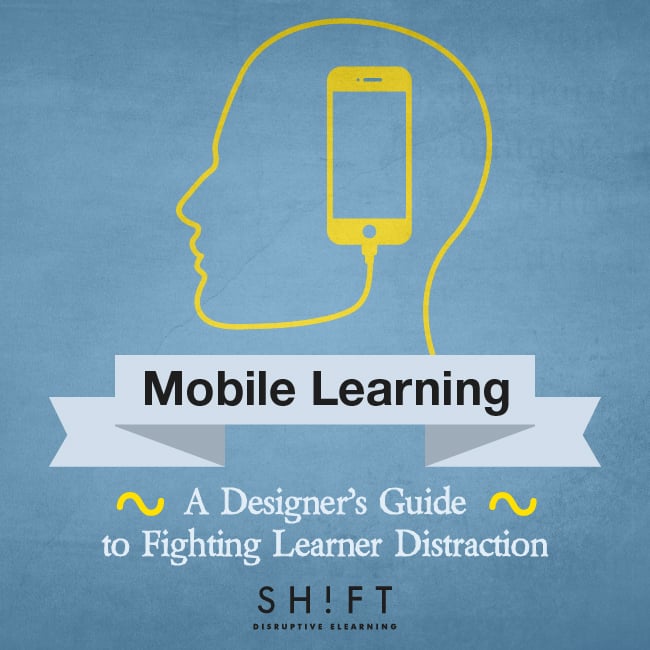One of the biggest issues in eLearning is distractions. The brain is constantly bombarded with stray thoughts even when users exert great self-control. The problem is yet more pronounced in mLearning, as devices themselves may cause distractions such as phone calls, email alerts, and the knowledge that the user could easily be doing something different. The average mobile user also has a short attention span — most people skim headlines and prefer bite-size content to long articles.
The reason learners forget so much of the information they learn within a course is partially due to distractions and partially to the fact that there is often too much content included in a single training lesson. In order to be successful, developers must create mobile learning courses that gains and sustains the attention of a user and can compete against distractions.
So here are some mobile learning design tips to engage the minds of learners in online training programs:

1. Content That Engages Users Instantly
The best way to avoid distraction of any sort is to, as one MoLeNET project report stated, “give the learners something interesting to do in the first place.”
In other words, the only way designers can keep users’ attention is by creating interesting, compelling, and varied content. If modules do not meet this criterion, learners will move on to more interesting things or use their devices for other purposes like games and Facebook.
Designers can give learners what they are looking for by using a few techniques: diversifying presentation formats, telling a story, helping them become emotionally involved with the content. The latter involves adding personal elements and situations that users can identify with. As they empathize with characters, contexts and scenarios you will help them draw them in and sustain interest and distractions desist.
2. Design Content with Mobile in Mind
Designers should take into consideration that some types of content are better suited for mobile than others. These include:
- Courses with location-specific importance.
- Modules where designers can easily package and present best-practice or advice tips.
- Self-contained processes for which users need to retrieve specific knowledge at a particular moment such as definitions or top tips. In other words, content that requires no introduction.
Recent research suggests that mLearning should be less like the content found in typical eLearning courses and more focused around support orientation. They are most effective as just-in-time or just-in-place modules or part of a broader learning intervention.
3. Avoiding Cognitive Load
Leaving out inessentials creates simpler mLearning courses and results in less distracted learners. This means eliminating any unrelated or decorative material, which only serves to pull learners’ attention away from actual information.
Secondly, the most important information needs to be at the top of slides or mentioned first in videos. If users are unable to finish a module, they will at least have absorbed the key details.
In short, modules should be free from “nice to know” content. Designers must restrict mobile learning courses to information that learners need to know for the specific syllabus.
“Small screen sizes force you to prioritize what really matters to your audience. There simply isn’t room for anything else.” Luke Wroblewski
4. Structuring Content for Short Attention Spans
A research conducted by Yahoo! in late 2011 confirmed that users engage in short activity burts. It showed that mobile users can't seem to put down their devices. Fifty-three percent of them say they snack on content during the day, usually between 8:30 am and 1 pm. But this "snacking" happens in chunks—a little bit of activity here, a little bit there. And it doesn't always happen between those hours. Learners just want to receive information quickly and process it rapidly.
This way, designers should aim to create bite-size chunks of information that take no longer than five minutes to process. Each of these sections needs to be available as a stand-alone module. Such structure allows users to learn in non-linear fashion and access information when they need it.
“Consider the fact that users expect to get the information they need in just a few clicks/taps. Structure information so it can be easily accessed” (Malamed, 2011).
5. Using Color Correctly
As developers are trying to reduce distractions, it may seem counterproductive to use color; however, visual cues, such as color, have a strong impact on first impressions (specially in mobile learning) and can influence a user’s opinion about a course within the first few seconds. It is important to use color only when it is appropriate; for instance with
- Color coding and icons to codify search results
- High contrast combinations
- Strong colors to act a triggers to attract learners’ attention and reduce the risk of forgetting information
- Matching colors to link related elements
- Colors that have certain connotations to imply meaning
- Consistency
- No distracting background color
6. Reducing Frustration
“Mobile users demand quick, clear, and easy-to-use courses, so interfaces should be intuitive and task-oriented.” (Quesinberry N. , 2011)
Additionally, users expect courses that load quickly on all types of browsers. If they're a tad slower, it can annoy them. Designers can avoid this by simply removing unnecessary images and other media and optimize their content for high-speed content loading.
For mLearning, designers also need to consider the ease of navigating on a mobile device and optimize design so that the interface is intuitive, task-oriented, and requires just a few clicks to reach any given place. Don't forget that mobile learners are navigating with the precision of a finger, rather than clicking with a mouse so using using clear, concise and consistent navigation cues across all screens is very important.
7. Applying Interactivity
Mobile users prefer active involvement to passive learning. In mLearning, developers can apply interactivity thoughtfully through real-time polls, games, interactive diagrams, exploration screens, hot spot and drag and drop exercises, and interactive video, where clicking on areas in the video leads to more information. Designers can use interactive video to spark interest in a subject during the basics and offer users the opportunity to learn more if they are interested. However, interactions need to be used sparsely, videos should only be used when necessary, as they take more time to load onto the screen.
There is more information about why interactive video is recommended for mLearning at this article from Learning Solutions Magazine.








